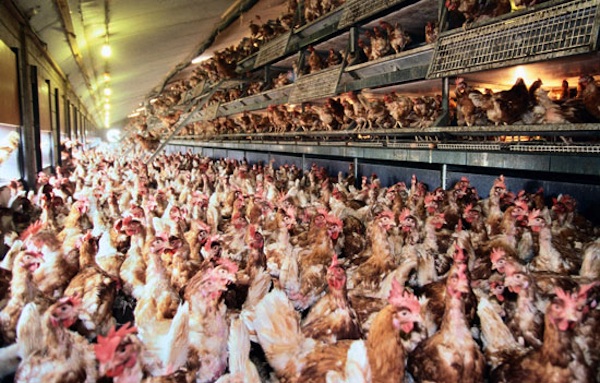How free is free range? ... Not very at all ... Egg industry body seeking ACCC approval to use "free range" label for farmers keeping 140,000 chooks to the hectare ... Action against false "free to roam" claims ... Trade Mark ... "Elysian Fields" embraces cooped and crushed ... Stephen Keim and Jordan Sosnowski report
 Home on the range
Home on the range
WHEN we pay a little extra to buy eggs labelled "Free Range" we have visions of happy chickens pecking their way across grassland, returning to their dwellings only to lay and roost for the night. Visions of high fences, razor wire and arc lights are far from our minds.
We have to be careful.
Those who do operate chook farms of the arc lights and razor wire kind can be cunning.
Labels evoke imagery of a free range lifestyle. We are attracted to "Shangri-la Chook Farms" or "Chook Farms of Leisure and Love" and we assume that strict regulations are in place to ensure that only saintly and kindly farmers can use the "free range" moniker.
There are rules. The free range label is protected by law.
However, our visions of Elysian Fields, in which our two-legged egg factories live and lay, may not be matched by reality. And reality may just be about to get a lot worse.
The Australian Poultry Industries Association (APIA) has recently applied to the ACCC to certify new standards for the production of free range poultry.
APIA represents Australia's largest poultry producers. If its application is granted, the term will become a certified trade mark that may be used to describe farms that keep up to 140,000 chickens per hectare.
A hectare is 10,000 square metres. It sounds like a lot of space, but not for 140,000 chickens in which to live their entire lives.
A hectare is equivalent to a square with each side measuring 100 metres: sort of like a square athletics track. Imagined in that way, it seems less free range and more cooped and crushed.
There is a group of animal farmers who are seeking to maintain minimal standards for humane farming.
They are called Humane Choice Standards and HCS uses the label ''True Free Range" and currently sets the maximum at 50,000 chickens per hectare, a bit more than a third of the number for which APIA is seeking a certified trade mark.
 Freedom: not the industry's idea of free range
Freedom: not the industry's idea of free range
APIA's justification for the certified trade mark is to create a national, uniform body of regulation that provides more clarity for producers and accurate information to consumers - all worthy objectives provided "free range" continues to represent humane standards of farming.
Animal welfare groups submit that the proposed certified trade mark distorts public expectations of "free range", and would mislead and take advantage of consumers.
The ACCC asked for submissions in relation to APIA's application for a certified trade mark and consultations closed recently.
The commission is responsible for approving the rules that govern the use of a certified trade mark. Once such a mark is approved, the owner becomes responsible for licensing other users to adopt it.
In the past, there has been litigation brought by the ACCC in respect of misleading free range labelling.
An action was brought against Turi Foods for claiming chickens were "free to roam" when they were reared indoors with their mobility severely restricted.
In an order to which Turi Foods consented, the Federal Court ordered the company to pay $100,000.
However, it is not always possible to track down and prosecute every operator that makes false claims.
If successful, it is APIA that becomes responsible for granting licences to poultry producers to adopt the free range logo on their products.
As a result, it falls to the industry itself to ensure that its members stick to the standards accepted by the ACCC.
APIA's proposal offloads that responsibility even further down the line. It makes its licensees responsible for ensuring that annual certification audits are carried out.
Thus, APIA pockets a fee for the grant of a licence. The licensed producer is made responsible for enforcing the standards under the certified trade mark. If a producer is found by an auditor to be conducting an even more inhumane system than the trade mark allows, the peak body can express a few pious clichés about "rotten apples" and the system stays in place.
There is therefore little incentive for APIA to use discretion or character checks when granting licences.
Even the auditors are appointed by APIA.
How humane is APIA's "free range" proposal?
The answer is not very and you do not have to accept our take on this.
In the Turi Foods' case the stocking density of chickens was found to be 30.92kg per square metre of floor area.
APIA's proposal is for a comparable stocking density of 28kg per square metre.
Turi Foods consented to the order that its conduct was a misleading use of the term "free to roam".
The official standards proposed for the term "free range" are almost as bad as those which produced the fine. Not a very encouraging start ... and it turns out that Turi Foods is a member of APIA.
Like Kennedy in Berlin, poultry producers will be able to say: "We are all Free Rangers now."
No longer will there be any point in being careful at the supermarket shelves. There will be no need for shady egg producers to label themselves "Elysian Fields", for they will be inside the tent.
Stephen Keim and Jordan Sosnowski